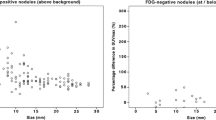Abstract
Objective
We present an automated scheme to correct PET max-uptake-values of small to medium-sized pulmonary nodules for motion blur and partial volume averaging. Both effects cause significant underestimation of PET max-uptake-values, particularly in nodules below 25 mm diameter, but nodules up to 75 mm might be affected. This compromises the power of PET for the differential diagnosis of such nodules, in particular benign versus malignant. Thus, correcting PET max-uptake-values has the potential to improve the classification of PET-positive pulmonary nodules.
Methods
The proposed correction algorithm relies on (i) determination of the actual size and shape of the nodule by segmentation of the nodule in the CT image and (ii) estimation of the effective local point-spread-function in the PET image, taking into account not only the inherently limited spatial resolution of the PET scanner, but also respiratory motion effects. Then the expected under-estimation of the PET max-uptake value in the nodule can be computed by simulation, and the correct PET max-uptake is obtained by multiplication with the correction factor (inverse of the under-estimation/recovery factor).
Results
Depending on the estimated nodule shape and blur width, the resulting SUV correction factors ranged from 1.0 to 11, with an average correction factor of 3.0, with higher values for smaller nodules. In comparison to SUV correction using a simplified spherical nodule model, the true-shape SUV correction factors were on average 30% higher. The feasibility of the method presented here is indicated by the high correlation between fitted and observed PET image profiles for clinical cases (average 0.995).
Conclusion
Blur and motion correction factors for standardized PET uptake values may significantly change the differential diagnosis of small pulmonary nodules. Feasibility and stability of the proposed automated combined SUV correction method as well as ease of use of the software tool have been demonstrated by retrospective analysis of real PET/CT patient datasets from clinical routine.
Similar content being viewed by others
References
Minn H, Zasadny KR, Quint LE, Wahl RL (1995) Lung cancer: reproducibility of quantitative measurements for evaluating 2-[F-18]-fluoro-2-deoxy-D-glucose uptake in PET. Radiology 198(1): 167–173
Rigo P, Hustinx R, Bury T (2006) PET and PET/CT imaging in lung cancer. In: Valk P, Delbeke D, Bailey DL, Townsend DW, Maisey MN (eds) Positron emission tomography—clinical practice. Springer, London
Gould MK, Maclean CC, Kuschner WG, Rydzak CE, Owens DK (2001) Accuracy of positron emission tomography for diagnosis of pulmonary nodules and mass lesions: a meta analysis. JAMA 285: 914–924
Erasmus JJ, McAdams HP, Patz EF Jr, Coleman RE, Ahuja V, Goodman PC (1998) Evaluation of primary pulmonary carcinoid tumor using FDG-PET. AJR 170: 1369–1373
Nie Y, Li Q, Li F, Pu Y, Appelbaum D, Doi K (2006) Integrating PET and CT information to improve diagnostic accuracy for lung nodules: a semiautomatic computer-aided method. J Nucl Med 47: 1075–1080
Herder GJ, Golding RP, Koekstra OS, Comans EF, Teule GJ, Postmus PE, Smit EF (2004) The performance of 18F-fluorodeoxyglucose positron emission tomography in small solitary pulmonary nodules. Eur J Nucl Med Mol Imaging 31(9): 1231–1236
Hoffman EJ, Huang SC, Phelps ME (1979) Quantitation in positron emission computed tomography: 1. Effect of object size. J Comput Assist Tomogr 3: 299–308
Kessler RM, Ellis JR Jr, Eden M (1984) Analysis of emission tomographic scan data: limitations imposed by resolution and background. J Comput Assist Tomogr 8: 514–522
Soret M, Bacharach SL, Buvat I (2007) Partial-volume effect in PET tumor imaging. J Nucl Med 48(6): 932–945
Keyes JW (1995) SUV: standard uptake or silly useless value?. J Nucl Med 36: 1836–1839
Basu S, Alavi A (2007) Partial volume correction of standardized uptake values and the dual time point in FDG-PET imaging: should these be routinely employed in assessing patients with cancer?. Eur J Nucl Med Mol Imaging 34(19): 1527–1529
Vik T, Kabus S, von Berg J, Ens K, Dries S, Klinder T, Lorenz C Validation and comparison of registration methods for free-breathing 4D lung-CT. In: Proceedings of SPIE 2008 medical imaging conference, vol 6914. SPIE, San Diego
Klinder T, Lorenz C, von Berg J, Renisch S, Ostermann J (2008) 4D-CT image-based lung motion field extraction and analysis. In: Proceedings of SPIE 2008 medical imaging conference, vol 6914. SPIE, San Diego
Hickeson M, Yun M, Matthies A, Zhuang H, Adam LE, Lacorte L, Alavi A (2002) Use of corrected standardized uptake value based on the lesion size on CT permits accurate characterization of lung nodules on FDG-PET. Eur J Nucl Med Mol Imaging 29(12): 1639–1647
El Naqa I, Low DA, Bradley JD, Visic M, Deasy JO (2006) Deblurring of breathing motion artefacts in thoracic PET images by deconvolution methods. Med Phys 33(10): 3587–3600
Bülow T, Arbash Meinel L, Wiemker R, Kose U, Shimauchi A, Newstead G (2007) Segmentation of suspicious lesions in dynamic, contrast-enhanced breast MR images. In: Proceedings of SPIE 2007 medical imaging conference, vol 6514. SPIE, San Diego
Wiemker R, Rogalla P, Blaffert T, Sifri D, Hay O, Shah E, Truyen R, Fleiter T (2005) Aspects of computer aided detection (CAD) and volumetry of pulmonary nodules using multislice CT. Br J Radiol 78(special issue):S46–S56
Wiemker R, Wormanns D, Beyer F, Blaffert T, Bülow T (2005) Improved sensitivity of dynamic CT with a new visualization method for radial distribution of lung nodule enhancement. In: Proceedings of SPIE 2005 medical imaging conference, vol 5746. SPIE, San Diego, pp 486–497
Author information
Authors and Affiliations
Corresponding author
Rights and permissions
About this article
Cite this article
Wiemker, R., Paulus, T., Kabus, S. et al. Combined motion blur and partial volume correction for computer aided diagnosis of pulmonary nodules in PET/CT. Int J CARS 3, 105–113 (2008). https://doi.org/10.1007/s11548-008-0212-y
Received:
Accepted:
Published:
Issue Date:
DOI: https://doi.org/10.1007/s11548-008-0212-y




